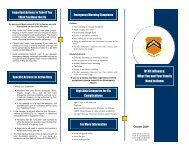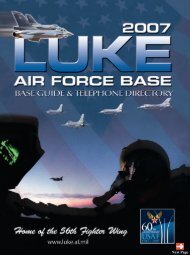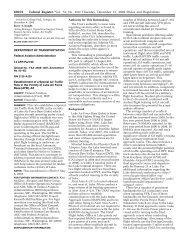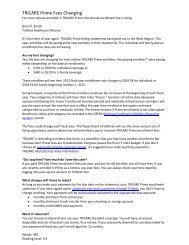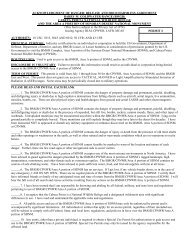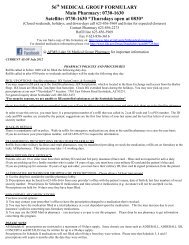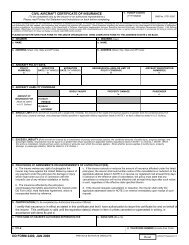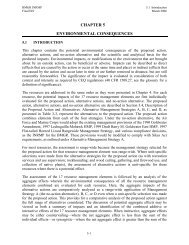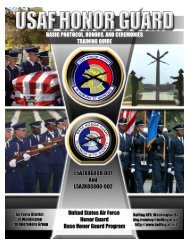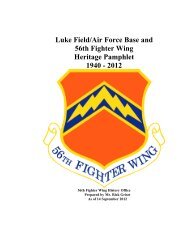MidAir Collision Avoidance (MACA) Program - Luke Air Force Base
MidAir Collision Avoidance (MACA) Program - Luke Air Force Base
MidAir Collision Avoidance (MACA) Program - Luke Air Force Base
You also want an ePaper? Increase the reach of your titles
YUMPU automatically turns print PDFs into web optimized ePapers that Google loves.
SHARE THE AIR<br />
<strong>Mid<strong>Air</strong></strong> <strong>Collision</strong> <strong>Avoidance</strong><br />
(<strong>MACA</strong>) <strong>Program</strong><br />
<strong>Luke</strong> <strong>Air</strong> <strong>Force</strong> <strong>Base</strong>, Arizona<br />
<strong>Luke</strong> AFB - <strong>MACA</strong> <strong>Program</strong><br />
56th Fighter Wing/Flight Safety<br />
7046 N. Fighter Country Ave (Bldg 470)<br />
<strong>Luke</strong> AFB, AZ 85309<br />
JAN 2009<br />
Phone: 623-856-6942/43<br />
Fax: 623-856-3464<br />
www.luke.af.mil/library/midaircollisionavoidance.asp<br />
TRAINING AMERICA’S BEST FIGHTER PILOTS!
Page i<br />
<strong>Luke</strong> AFB - <strong>MACA</strong> <strong>Program</strong><br />
<strong>Luke</strong> AFB - <strong>MACA</strong> <strong>Program</strong> Page 20<br />
Dear Fellow Aviators,<br />
Midair collisions are an area of vital concern to everyone who<br />
flies an airplane. The actual number of midairs between <strong>Air</strong> <strong>Force</strong><br />
aircraft and general aviation aircraft is relatively low; however, 80<br />
percent of reported <strong>Air</strong> <strong>Force</strong> near misses occur with general<br />
aviation aircraft. Because of increasing general aviation traffic<br />
and heavy concentrations of military aircraft involved in training,<br />
we want to inform you about the flying activity at <strong>Luke</strong> <strong>Air</strong> <strong>Force</strong><br />
<strong>Base</strong>.<br />
The purpose of this pamphlet is to alert you to the many<br />
areas of high midair collision potential in the skies over Arizona<br />
and to discuss ways to make them safer. This pamphlet will<br />
describe available radar services, the types of military aircraft you<br />
may encounter, arrival and departure routes, military operating<br />
areas, and low level routes. It also provides information regarding<br />
midair collisions and ways we can all help avoid them.<br />
The pilots and controllers assigned to <strong>Luke</strong> <strong>Air</strong> <strong>Force</strong> <strong>Base</strong><br />
are committed to maintaining a valid and active midair collision<br />
avoidance program. We hope this pamphlet will serve to increase<br />
your understanding of <strong>Luke</strong>’s flying activities so we may continue<br />
to safely share the skies. If you desire any additional information<br />
or a briefing from the <strong>Luke</strong> <strong>Air</strong> <strong>Force</strong> <strong>Base</strong> <strong>MACA</strong> team members<br />
concerning our operations, please contact the <strong>Luke</strong> Flight Safety<br />
Office at (623) 856-6942 or the <strong>Air</strong>field Operations Flight Commander<br />
at (623) 856-7341.<br />
Additional copies of this pamphlet can be obtained by calling<br />
the <strong>Luke</strong> Flight Safety Office. Additional information can be obtained<br />
via <strong>Luke</strong>’s public <strong>MACA</strong> website:<br />
http://www.luke.af.mil/library/midaircollisionavoidance.asp<br />
<strong>Collision</strong> <strong>Avoidance</strong> and YOU<br />
Ever landed and got out of your plane with your hands sweaty and body shaking<br />
because someone nearly took your wing off? If so, you’re not alone. As aviation<br />
activity increases throughout the US, the possibility of having a near midair or<br />
actual collision increases. The FAA has instituted policies to alleviate the midair<br />
collision potential, but the ultimate responsibility lies with YOU! Below are several<br />
rules to live by… in order to make flying safer for all.<br />
1. PLAN AHEAD - Thoroughly plan and review your intended route of flight<br />
before walking to your aircraft. If possible, plan to avoid alert areas, MTR’s, and<br />
MOA’s. Check NOTAM’s and identify potential conflict areas. The following<br />
website depicts military airspace near you:<br />
(www.SeeAndAvoid.org)<br />
2. SEE AND AVOID - Scan the airspace ahead of your flight path and to the side<br />
using a disciplined scan pattern. Also, periodically check behind you since the<br />
majority of midairs occur when one aircraft overtakes another.<br />
3. CLEAR - Before executing a climb, turn, descent, or any other maneuver,<br />
ensure the area is clear!<br />
4. COMMUNICATE - When flying into or out of uncontrolled airports,<br />
broadcast your position and intentions. Request and use all available RADAR<br />
services whenever possible. Finally, don’t relax your visual scan even in a<br />
RADAR environment.<br />
5. SQUAWK - If your aircraft is transponder equipped, turn it on and reply on<br />
both Mode 3/A and C.<br />
6. BE SEEN - In order to enhance the see and avoid concept, you are encouraged<br />
to turn on your anti-collision lights and/or other appropriate lights whenever<br />
the engine is running. You’re further encouraged to turn on your landing light<br />
(within POH recommendations) when operating below 10,000’ MSL, day or<br />
night, but especially within 10 miles of an airport or in areas of reduced<br />
visibility.<br />
PROFILE OF A MIDAIR<br />
A three year study of midair collisions involving civilian aircraft by the NTSB<br />
determined the following:<br />
1. The occupants of most midairs were on a pleasure flight with no filed flight<br />
plan.<br />
2. Nearly all midair collisions occurred in VFR conditions during weekend<br />
daylight hours.<br />
3. The majority of midairs were the result of a faster aircraft overtaking a<br />
slower aircraft.<br />
4. NO ONE is immune. Experience levels ranged from initial solo to the 15,000<br />
hour veteran.<br />
5. The majority of midairs occurred at uncontrolled airports below 3000’.<br />
6. Enroute midaris occurred below 8,000 and within 25 miles of the airport of<br />
intended landing.<br />
7. Flight instructors were onboard one of the aircraft in 37% of the midairs.
Page 19 <strong>Luke</strong> AFB - <strong>MACA</strong> <strong>Program</strong><br />
<strong>Luke</strong> AFB - <strong>MACA</strong> <strong>Program</strong> Page ii<br />
Geometry of a <strong>Collision</strong><br />
Table of Contents<br />
<strong>Luke</strong> AFB Location and Operation 1<br />
F-16 Operating Information 2<br />
Local Area Map 3<br />
Gladden / Bagdad MOA 4<br />
Sells MOA 5<br />
Outlaw / Jackal MOA 6<br />
Restricted <strong>Air</strong>space (R-2301E / R-2304 / R-2305) 7<br />
Alert Area A-231 8<br />
RWY 03 Departures 9<br />
RWY 21 Departures 10<br />
RWY 03 Arrivals 11<br />
RWY 21 Arrivals 12<br />
RWY 03 Traffic Pattern 13<br />
RWY 21 Traffic Pattern 14<br />
<strong>Luke</strong> AFB and AUX-1 Radar Pattern 15<br />
Gila Bend AFAF Traffic Pattern 16<br />
Reaction Chart 17<br />
Closure Rate 18<br />
Geometry of a <strong>Collision</strong> 19<br />
<strong>Collision</strong> <strong>Avoidance</strong> and YOU! 20
10,000’ x 150’<br />
Page 1<br />
<strong>Luke</strong> AFB - <strong>MACA</strong> <strong>Program</strong><br />
<strong>Luke</strong> AFB - <strong>MACA</strong> <strong>Program</strong> Page 18<br />
<strong>Luke</strong> AFB Location and Operation<br />
Closure Rate<br />
Location:<br />
<strong>Air</strong>field Identifier:<br />
Coordinates:<br />
Elevation:<br />
Frequencies:<br />
Operating Hours:<br />
19 miles West of Phoenix Sky Harbor<br />
KLUF<br />
N 33 32.26 W 112 22.8<br />
1090’<br />
Approach - 125.45/ 118.15<br />
Tower - 119.1<br />
Ground - 133.175<br />
ATIS - 134.925<br />
Sunrise - 2300(L) Mon - Thu<br />
LUKE Sunrise AIRFIELD - 1800(L) Fri-Sun DIAGRAM<br />
<strong>Luke</strong> AFB is closed<br />
to all civil traffic.<br />
Extensive, high<br />
speed student jet<br />
training in progress.<br />
Contact <strong>Luke</strong> Approach<br />
for traffic<br />
advisories.<br />
N<br />
W<br />
x<br />
x<br />
x<br />
S<br />
x<br />
x x x<br />
A<br />
E<br />
HYDRAZINE / HOT BRAKE<br />
HUNG GUN / FLARE / ROCKET<br />
ALTERNATE DEARM<br />
(SPOTS NOT MARKED)<br />
A<br />
* CLOSED TO FTR<br />
AIRCRAFT<br />
x<br />
x<br />
x<br />
21R<br />
BAK-9<br />
BAK-9<br />
BAK-12<br />
1422’<br />
x x x x<br />
F*<br />
9909’ x 150’<br />
LUF<br />
CH 77<br />
BAK-12<br />
1451’<br />
21L<br />
BAK-12<br />
1451’<br />
x x x<br />
E (LIVE)<br />
F<br />
B<br />
C<br />
C<br />
C<br />
C<br />
D<br />
ARM/DEARM<br />
(8 SPOTS)<br />
E<br />
HYDRAZINE / HOT BRAKE<br />
BORESIGHT (6 SPOTS)<br />
BASE OPS<br />
B<br />
D<br />
HOT BRAKE<br />
CONTROL<br />
TOWERS<br />
B<br />
WATER<br />
TOWER<br />
WATER<br />
TOWER<br />
ALT HOT BRAKE<br />
(SHORT ECHO CLOSED)<br />
H<br />
C<br />
ARM/DEARM<br />
(8 SPOTS)<br />
I<br />
BAK-9<br />
BAK-12<br />
1500’<br />
I<br />
03R<br />
HYDRAZINE / HOT BRAKE<br />
BORESIGHT (6 SPOTS)<br />
BAK-9<br />
03L<br />
1-4<br />
HYDRAZINE / HOT BRAKE<br />
HUNG GUN / FLARE / ROCKET<br />
ALTERNATE DEARM (6 SPOTS)
Page 17<br />
<strong>Luke</strong> AFB - <strong>MACA</strong> <strong>Program</strong><br />
<strong>Luke</strong> AFB - <strong>MACA</strong> <strong>Program</strong> Page 2<br />
Reaction Chart<br />
F-16 Operating Information<br />
The F-16 is a multi-role fighter. It can do everything from<br />
dropping bombs to providing air superiority. <strong>Luke</strong> is the<br />
only active duty F-16 training base for the USAF and the<br />
largest single F-16 base worldwide. There are over two hundred<br />
F-16s assigned at <strong>Luke</strong>. All phases of F-16 training for<br />
all USAF F-16 pilots and some foreign countries is conducted<br />
here. Most F-16s travel in even numbers, either 2 or<br />
4 together, except in the local pattern where they’ll fly as singles.<br />
F-16s routinely fly 350 kts on departure and 300 kts on<br />
recovery and in the traffic pattern. In the Military Operations<br />
Areas (MOAs), airspeeds range from 150 kts to supersonic.<br />
On Military Training Routes (MTRs), F-16s fly 500 kts at 500’<br />
AGL. While in the MOAs or on MTRs, F-16s generally fly 1-<br />
2 nm line abreast with another pair line abreast 2-3 nm in<br />
trail. So, if you see one F-16, look for others… chances are<br />
good there will be another F-16 close by.<br />
1-2nm<br />
2-3nm<br />
1-2nm
Page 3 <strong>Luke</strong> AFB - <strong>MACA</strong> <strong>Program</strong><br />
<strong>Luke</strong> AFB - <strong>MACA</strong> <strong>Program</strong> Page 16<br />
NELLIS 12<br />
LOCAL AREA MAP<br />
GILA BEND PATTERN<br />
GBN TWR CH 8<br />
Gila Bend AFAF Traffic Pattern<br />
TOWN OF<br />
GILA BEND<br />
CAUTION<br />
DO NOTFLY BELOW 2,500 MSL<br />
W/IN 3NM OF GBN VORTAC<br />
SUNNY<br />
I-8<br />
3NM INITIAL<br />
GILA BEND<br />
GBN 113<br />
CATTLE PENS<br />
KINGMAN<br />
DRK 88<br />
WINSLOW MUNI<br />
OVERHEAD 2400<br />
YUMA 84<br />
R-2306<br />
R-2309<br />
BAGDAD<br />
GLADDEN<br />
YARNELL<br />
LUKE<br />
SKY HARBOR 103<br />
BXK 43<br />
GOODYEAR<br />
GILA BEND 113<br />
R-2301W R-2301E R-2304<br />
R-2305<br />
SELLS<br />
LOVE FIELD<br />
TFD 95<br />
DEER VALLEY<br />
WILLIAMS 80<br />
PINAL AIRPARK<br />
RUBY<br />
FUZZY<br />
OUTLAW<br />
JACKAL<br />
DAVIS MONTHAN 123<br />
TUCSON 107<br />
R-2303B<br />
COOLY<br />
AUX-6<br />
360<br />
RWY 17<br />
035<br />
170<br />
RWY 35<br />
RWY 35<br />
STRAIGHTIN 1900 (35 ONLY)<br />
BREAKOUT 2900<br />
LOW CLOSED 1700<br />
DEPARTEASTTO LUF<br />
ABOVE 4,000’ VFR.<br />
CONTACTLUKE CH 4<br />
SFO PATTERN<br />
OVERHEAD: 10K MAX, CLIMBOUT WEST<br />
NORMALLY, 360 PATTERN, STAY SOUTH OF I-8<br />
RANDOM: PROCEED TO LOW OR BASE KEY<br />
ST-IN: REPORT 10NM THEN 5NM W/GEAR.<br />
IF RNG 3 BECOMES ACTIVE BE PREPARED TO<br />
BREAKOUT. ST-IN TO 35 ONLY<br />
In addition to Restricted airspace, the Gladden, Bagdad and Sells MOA’s are the most<br />
highly used areas for <strong>Luke</strong> F-16’s. Operations are conducted sunrise to 2300(L),<br />
Mon-Fri and sometimes Sat. Operations 1-2 in the Sunny MOA & ATCAA are<br />
conducted from 12,000 MSL - FL290. Numerous MTRs transit in and around <strong>Luke</strong><br />
and the Phoenix area. For additional information on special use airspace please refer<br />
to Sectional Charts, local NOTAMs, etc.<br />
LOW CLOSED PATTERN IS USED TO PRACTICE CIRCLING APP PICTURE.<br />
REMAIN VFR AND AT 1700’ MSL UNTIL NORMAL PICTURE IS OBTAINED.<br />
The procedures above are used by <strong>Luke</strong> assigned F-16’s. Gila Bend AFAF is<br />
utilized for practice touch-and-go landings, simulated flameout patterns, and as an<br />
emergency divert field. Of note, F-16 traffic should remain South of I-8. Upon<br />
recovery, F-16’s should climb above 4000’ before turning North toward <strong>Luke</strong><br />
AFB.
Page 15<br />
<strong>Luke</strong> AFB - <strong>MACA</strong> <strong>Program</strong><br />
<strong>Luke</strong> AFB - <strong>MACA</strong> <strong>Program</strong> Page 4<br />
<strong>Luke</strong> AFB and AUX-1 Radar Pattern<br />
Gladden / Bagdad MOA<br />
GLADDEN MOA & ATCAA<br />
ACTIVE: SUNRISE - 2300(L) MON - FRI (SOMETIMES SAT)<br />
ALTITUDES: 7000’ MSL (5000’ AGL) - FL330<br />
While on radar vectors for instrument training, the greatest conflicts with civil traffic<br />
is in the vicinity of the Arrowhead housing area and inside 10NM final. Please<br />
squawk, talk and LOOK for other aircraft in this busy airspace.<br />
If transiting the airspace depicted above, it is recommended you contact <strong>Luke</strong><br />
Approach on 118.15 or 125.45 for traffic information.<br />
BAGDAD MOA & ATCAA<br />
ACTIVE: SUNRISE - 2300(L) MON - FRI (SOMETIMES SAT)<br />
ALTITUDES: 7000’ MSL (5000’ AGL) - FL280<br />
These are <strong>Luke</strong>’s most highly utilized MOA’s. Operations are generally conducted<br />
above 10,000 MSL, but certain missions require transitions to the 7,000 MSL floor.<br />
Also, when ABQ Center “caps” the top of the airspace or when weather is a factor,<br />
missions will be conducted in the lower altitudes of the Gladden and Bagdad MOA’s.<br />
PLEASE CONTACT LUKE APPROACH ON 118.15 OR 125.45 FOR<br />
ADVISORIES
Page 5 <strong>Luke</strong> AFB - <strong>MACA</strong> <strong>Program</strong><br />
<strong>Luke</strong> AFB - <strong>MACA</strong> <strong>Program</strong> Page 14<br />
Sells MOA<br />
RWY 21 Traffic Pattern<br />
SELLS MOA & ATCAA<br />
ACTIVE: SUNRISE - 2300(L) MON - FRI (SOMETIMES SAT)<br />
ALTITUDES: 3000’ AGL - FL510<br />
(This airspace is also used by military aircraft from Tucson and Davis-Monthan AFB.)<br />
USE CAUTION WHEN TRANSITING SELLS MOA - NUMEROUS MILITARY<br />
TRAINING ROUTES (MTRs) TRANSIT THE AIRSPACE<br />
MILITARY AIRCRAFT ON MTRs ROUTINELY OPERATE AT SPEEDS IN<br />
EXCESS OF 500KTS DOWN TO 500’ AGL<br />
CONTACT ABQ CTR OR GILA BEND AF AUXILIARY FIELD FOR ADVISORIES<br />
EXERCISE EXTREME CAUTION WHEN FLYING IN THE VICINITY OF THE<br />
SUBSTATION (NW OF SUN CITY) THE DESERTED CATERPILLAR TRACTOR<br />
GROUNDS (SW OF LUKE), AND THE ABANDONED AIRFIELDS (NORTH &<br />
SOUTH OF LUKE). THESE AREAS ARE USED AS REPORTING AND ENTRY<br />
POINTS INTO LUKE’S TRAFFIC PATTERN FOR BASE ASSIGNED F-16’s.<br />
PLEASE CONTACT LUKE APPROACH ON 118.15 OR 125.45 FOR<br />
ADVISORIES
Page 13 <strong>Luke</strong> AFB - <strong>MACA</strong> <strong>Program</strong><br />
<strong>Luke</strong> AFB - <strong>MACA</strong> <strong>Program</strong> Page 6<br />
RWY 03 Traffic Pattern<br />
Outlaw / Jackal MOA<br />
BLACK<br />
BLUE<br />
RED<br />
- PATTERN ENTRY FROM SOUTH (I.e. VALLEY RECOVERY)<br />
- PATTERN ENTRY FROM TANKZ RECOVERY<br />
- PATTERN ENTRY FROM AUX 1 (INSTM PRACTICE AIRFIELD)<br />
OUTLAW MOA & ATCAA<br />
ACTIVE: SUNRISE - 2300(L) MON - FRI (SOMETIMES SAT)<br />
ALTITUDES: 8000’ MSL (3000’ AGL) - FL510 (NORMALLY CAPPED AT FL300)<br />
JACKAL MOA & ATCAA<br />
ACTIVE: SUNRISE - 2300(L) MON - FRI (SOMETIMES SAT)<br />
ALTITUDES: 11000’ MSL (3000’ AGL) - FL510 (NORMALLY CAPPED AT FL300)<br />
USE CAUTION IN THE VICINITY OF BUCKEYE AND THE WHITE TANKS<br />
CONTACT ABQ CTR FOR ADVISORIES
Page 7 <strong>Luke</strong> AFB - <strong>MACA</strong> <strong>Program</strong><br />
<strong>Luke</strong> AFB - <strong>MACA</strong> <strong>Program</strong> Page 12<br />
Restricted <strong>Air</strong>space<br />
RWY 21 Arrivals<br />
10-14000’<br />
3-3500’<br />
5500’<br />
2500-3000’<br />
3500-4000’<br />
3500-5000’<br />
6-8000’<br />
7000’<br />
10-12000’<br />
R-2301E<br />
ACTIVE: SUNRISE - 2300(L) MON - FRI (SOMETIMES SAT)<br />
ALTITUDES: SFC - FL800<br />
R-2304/2305<br />
ACTIVE: SUNRISE - 2300(L) MON - FRI (SOMETIMES SAT)<br />
ALTITUDES: SFC - FL240<br />
CONTACT ABQ CTR OR GILA BEND AF AUXILIARY FIELD FOR ADVISORIES<br />
7000’<br />
8000’<br />
HIGHEST CONFLICT AREAS ARE NEAR BUCKEYE, AUX 1 (LUKE’S INSTM<br />
PRACTICE AIRFIELD), AND IN THE VICINITY OF LUKE’S PATTERN ENTRY<br />
POINTS (THE SUBSTATION NW OF SUN CITY, THE ABANDONED AIRFIELD<br />
AT THE SW CORNER OF BELL AND LITCHFIELD RD, AND THE ABANDONED<br />
CATERPILLAR TRACTOR PROVING GROUNDS JUST SW OF THE BASE).<br />
PLEASE EXERCISE CAUTION AND REQUEST FLIGHT FOLLOWING IF ABLE.
Page 11<br />
<strong>Luke</strong> AFB - <strong>MACA</strong> <strong>Program</strong><br />
<strong>Luke</strong> AFB - <strong>MACA</strong> <strong>Program</strong> Page 8<br />
RWY 03 Arrivals<br />
Alert Area A-231<br />
10-14000’<br />
5500’<br />
3500’<br />
3000-3500’<br />
3500-5000’<br />
6-8000’<br />
7000’<br />
10-12000’<br />
7000’<br />
8000’<br />
BLACK<br />
BLUE<br />
- GROUNDTRACK OF THE VALLEY RECOVERY<br />
- GROUNDTRACK OF THE TANKZ RECOVERY<br />
ARRIVALS FROM THE SOUTH FUNNEL TO GBN VORTAC ENROUTE TO LUKE<br />
ARRIVALS FROM THE NORTH ENTER THE LUKE TRAFFIC PATTERN FROM<br />
NORTHWEST OF THE WHITE TANKS<br />
ALERT AREA A-231<br />
ACTIVE: CONTINUOUS<br />
ALTITUDES: 500’ AGL - 6500’ MSL<br />
EXERCISE EXTREME CAUTION FOR<br />
HIGH SPEED JET TRAFFIC IN A-231<br />
PLEASE CONTACT LUKE APCH ON 118.15 / 125.45 FOR TRAFFIC ADVISORIES
Page 9<br />
<strong>Luke</strong> AFB - <strong>MACA</strong> <strong>Program</strong><br />
<strong>Luke</strong> AFB - <strong>MACA</strong> <strong>Program</strong> Page 13<br />
<strong>Luke</strong> AFB - <strong>MACA</strong> <strong>Program</strong> Page 10<br />
Rwy 03 Departures<br />
Rwy 21 Departures<br />
4500-7000’<br />
9-14,000’<br />
7000’<br />
17 -19000’<br />
9000’<br />
17 -19,000’<br />
6000’<br />
6000’<br />
6000’<br />
6000’<br />
5000’<br />
6000’<br />
5000’<br />
8000’<br />
8000’<br />
5-8000’<br />
8000’<br />
8000’<br />
5-8000’<br />
5-9000’<br />
5-9000’<br />
BLACK<br />
BLUE<br />
RED<br />
GREEN<br />
- VFR SOUTH & BUSCO DEPARTURES GROUND TRACKS<br />
- TIRON-GLADDEN DEPARTURE<br />
- VFR NORTH & LAKE DEPARTURES<br />
- NORDY DEPARTURE<br />
THE HIGHEST POTENTIAL CONFLICT AREAS CONTINUE TO BE ON LUKE’S<br />
SOUTHERN DEPARTURES (SOUTH OF GOODYEAR AIRPORT) AND IN THE<br />
VICINITY OF LAKE PLEASANT. PRACTICE DISCIPLINED SEARCH PATTERNS<br />
AND IT IS RECOMMENDED YOU CONTACT LUKE APPROACH FOR TRAFFIC<br />
ADVISORIES.<br />
PLEASE CONTACT LUKE APPROACH ON 118.15 OR 125.45 FOR<br />
ADVISORIES<br />
PLEASE CONTACT LUKE APPROACH ON 118.15 OR 125.45 FOR<br />
ADVISORIES



